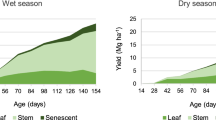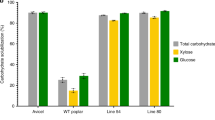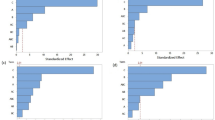Abstract
The agronomic and pulping performance of transgenic trees with altered lignin has been evaluated in duplicated, long-term field trials. Poplars expressing cinnamyl alcohol dehydrogenase (CAD) or caffeate/5-hydroxy-ferulate O-methyltransferase (COMT) antisense transgenes were grown for four years at two sites, in France and England. The trees remained healthy throughout the trial. Growth indicators and interactions with insects were normal. No changes in soil microbial communities were detected beneath the transgenic trees. The expected modifications to lignin were maintained in the transgenics over four years, at both sites. Kraft pulping of tree trunks showed that the reduced-CAD lines had improved characteristics, allowing easier delignification, using smaller amounts of chemicals, while yielding more high-quality pulp. This work highlights the potential of engineering wood quality for more environmentally benign papermaking without interfering with tree growth or fitness.
This is a preview of subscription content, access via your institution
Access options
Subscribe to this journal
Receive 12 print issues and online access
$209.00 per year
only $17.42 per issue
Buy this article
- Purchase on Springer Link
- Instant access to full article PDF
Prices may be subject to local taxes which are calculated during checkout






Similar content being viewed by others
References
Baucher, M., Monties, B., van Montagu, M. & Boerjan, W. Biosynthesis and genetic engineering of lignin. Crit. Rev. Plant Sci. 17, 125–197 (1998).
Whetten, R.W., Mackay, J.J. & Sederoff, R.R. Recent advances in understanding lignin biosynthesis. Annu. Rev. Plant Physiol. Mol. Biol. 49, 585–609 (1998).
Van Doorsselaere, J. et al. A novel lignin in poplar trees with a reduced caffeic acid 5-hydroxyferulic acid O-methyltransferase activity. Plant J. 8, 855–864 (1995).
Lapierre, C. et al. Structural alterations of lignins in transgenic poplars with depressed cinnamyl alcohol dehydrogenase or caffeic acid O-methyltransferase activity have an opposite impact on the efficiency of industrial Kraft pulping. Plant Physiol. 119, 153–163 (1999).
Jouanin, L. et al. Lignification in transgenic poplars with extremely reduced caffeic acid O-methyltransferase activity. Plant Physiol. 123, 1363–1373 (2000).
Franke, R. et al. Modified lignin in tobacco and poplar plants over-expressing the Arabidopsis gene encoding ferulate 5-hydroxylase. Plant J. 22, 223–234 (2000).
Baucher, M. et al. Red xylem and higher lignin extractability by down-regulating a cinnamyl alcohol dehydrogenase in poplar. Plant Physiol. 112, 1479–1490 (1996).
Hu, W.J. et al. Repression of lignin biosynthesis promotes cellulose accumulation and growth in transgenic trees. Nat. Biotechnol. 17, 808–812 (1999).
Hopkins, D.W., Webster, E.A., Chudek, J.A. & Halpin, C. Decomposition of stems from tobacco plants with genetic modifications to lignin biosynthesis. Soil Biol. Biochem. 33, 1455–1462 (2001).
Hopkins, D.W. & Shiel, R.S. Size and activity of soil microbial communities in long-term experimental grassland plots treated with manure and inorganic fertilizers. Biol. Fertil. Soils 22, 66–70 (1996).
Cherney, J.H., Cherney, D.J.R., Akin, D.E. & Axtell, J.D. Potential of brown-midrib, low-lignin mutants for improving forage quality. Adv. Agron. 46, 157–198 (1991).
MacKay, J.J. et al. Inheritance, gene expression, and lignin characterization in a mutant pine deficient in cinnamyl alcohol dehydrogenase. Proc. Natl. Acad. Sci. USA 94, 8255–8260 (1997).
Strauss, S.H. et al. Forest biotechnology makes its position known. Nat. Biotechnol. 17, 1145 (1999).
Castellani, E., Freccero, V. & Lapietra, G.F. Proposta di una scala di differenziazione delle gemme fogliari del pioppo utile per gli interventi antiparassitari. G. Bot. Ital. 101, 355–360 (1967).
Wyrambik, D. & Grisebach, H. Purification and properties of isoenzyme of cinnamyl alcohol dehydrogenase from soybean cell suspension culture. Eur. J. Biochem. 59, 9–15 (1975).
Dence, C. Lignin determination. in Methods in Lignin Chemistry (eds Dence, C. & Lin, S.) 33–61 (Springer, Berlin, 1992).
Lapierre, C., Pollet, B. & Rolando, C. New insight into the molecular architecture of hardwood lignins by chemical degradative methods. Res. Chem. Intermediates 21, 397–412 (1995).
Gullichsen, J. & Fogelholm, C-J. (eds). Papermaking Science and Technology, Chemical Pulping, Book 6 (Tappi Press, Helsinki, Finland, 2000).
Acknowledgements
We thank technical staff who managed both field trials and Frédéric Legée for Klason determinations. Field trials were funded by the European Commission (FAIR, CT95-0424), soil analyses by the Natural Environment Research Council, and decomposition work by the Biotechnology and Biological Sciences Research Council.
Author information
Authors and Affiliations
Corresponding author
Supplementary information
Rights and permissions
About this article
Cite this article
Pilate, G., Guiney, E., Holt, K. et al. Field and pulping performances of transgenic trees with altered lignification. Nat Biotechnol 20, 607–612 (2002). https://doi.org/10.1038/nbt0602-607
Received:
Accepted:
Issue Date:
DOI: https://doi.org/10.1038/nbt0602-607
This article is cited by
-
Growth adaptability and foreign gene stability of TaLEA transgenic Populus simonii × nigra
Annals of Forest Science (2021)
-
Tissue-specific Transcriptome analysis reveals lignocellulose synthesis regulation in elephant grass (Pennisetum purpureum Schum)
BMC Plant Biology (2020)
-
Simultaneous manipulation of lignin structure and secondary cell wall formation in transgenic poplar
Journal of Wood Science (2020)
-
Alterations in the phenylpropanoid pathway affect poplar ability for ectomycorrhizal colonisation and susceptibility to root-knot nematodes
Mycorrhiza (2020)
-
Identification of putative lignin biosynthesis genes in Betula pendula
Trees (2020)



